By Ningchuan, Cloud Technology Era
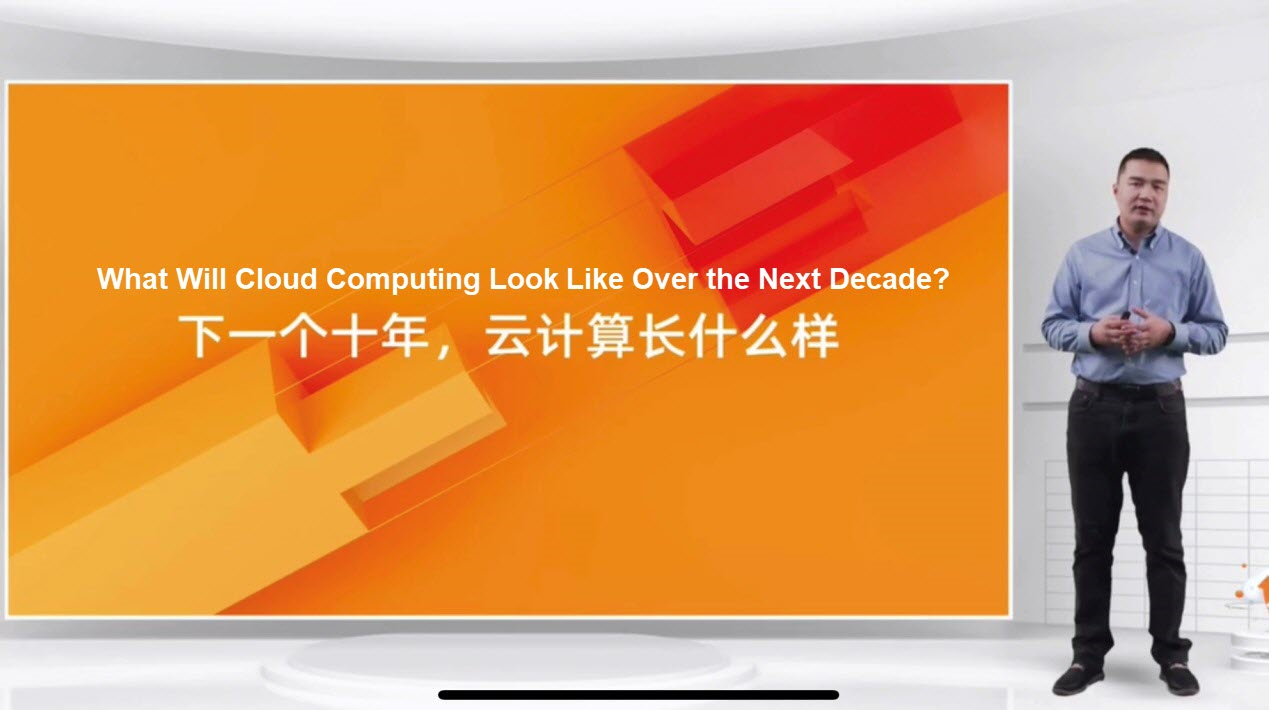
Undoubtedly, the COVID-19 pandemic in 2020 has redefined the cloud computing industry. With the explosive growth of online business due to the pandemic, many enterprises and institutions have migrated their offline business online. Even the most traditional industries, such as education, agriculture, real estate, and construction, have begun to migrate to the cloud on a large scale. Public cloud data centers in Europe have seen an explosion in demands, which was previously unimaginable.
In the Chinese market, the cloud computing industry experienced a period of expansion that spans from 2010 to 2020. Alibaba Cloud put down its first line of code in 2009 and launched the first generation of Elastic Compute Service (ECS) in 2010. As one of the premier enterprises in China's public cloud industry, Alibaba Cloud has connected the Chinese market to the public cloud. The market was initially suspicious since people had a poor understanding of the technology. People gradually embraced cloud computing as it grew, and as they started understanding the technology and market structure. Eventually, many vendors adopted cloud computing, and China's cloud computing industry went through its initial growth stage from 2010 to 2020.
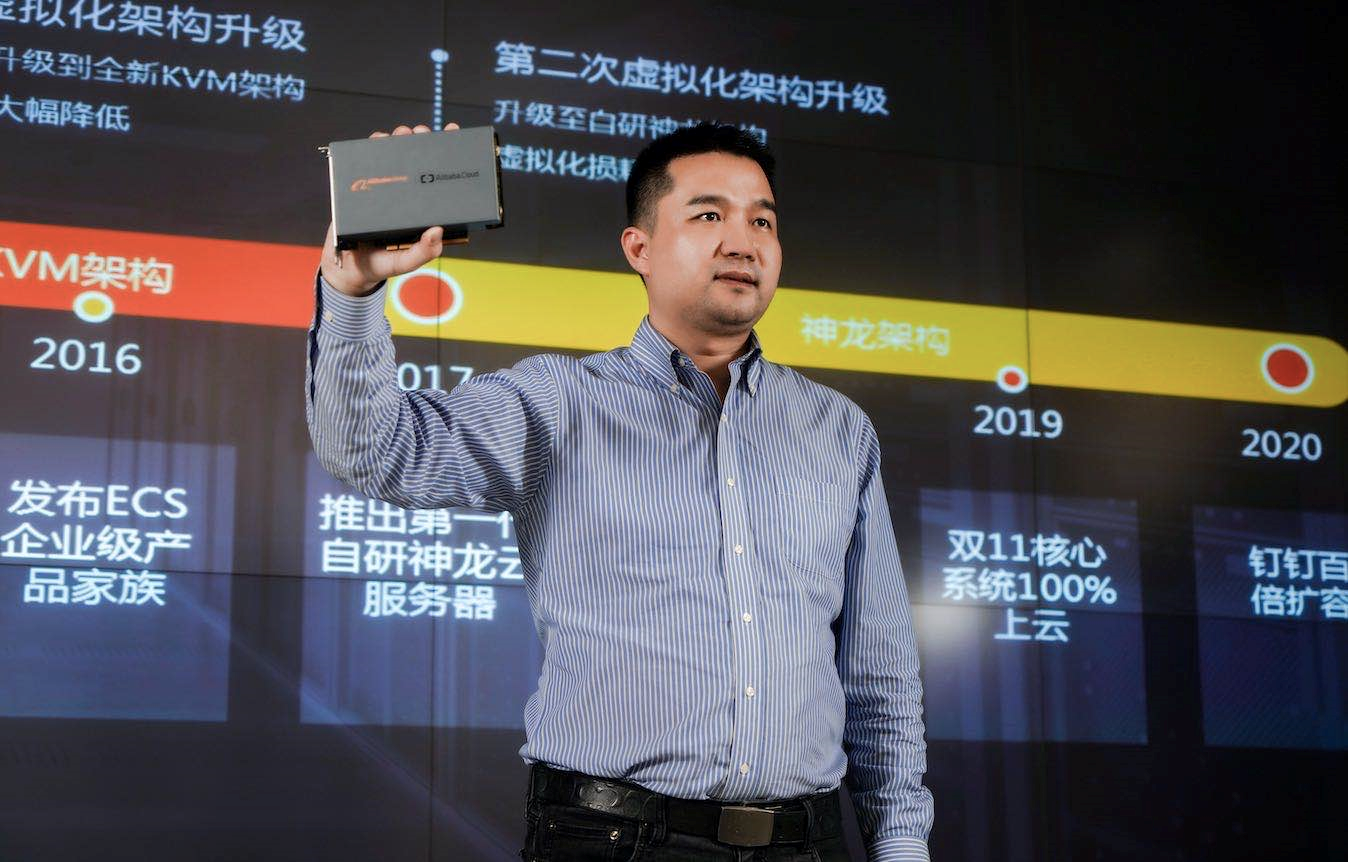
(Zhang Xiantao, the Head of Elastic Computing at Alibaba Cloud)
Now, we want to know how the cloud computing industry will develop over the decade following the COVID-19 pandemic. On July 15, 2020, Alibaba Cloud held its annual elastic computing launch event and announced the release of its proprietary third-generation X-Dragon cloud servers and new-generation ECS product family. When talking about the next decade of cloud computing, Zhang Xiantao, the Head of Elastic Computing at Alibaba Cloud, says the cloud computing model will reversely reconstruct basic hardware and software. The purpose of Alibaba Cloud's proprietary integrated hardware and software architecture and comprehensive implementation of cloud-native is to reconstruct the cloud computing infrastructure. This is the idea for the future.
Do Alibaba's proprietary X-Dragon servers allow enterprises to recreate their own data centers? During an interview at the annual 2020 Alibaba Cloud launch event, Zhang Xiantao laughed and said that many enterprise customers asked if they could purchase these servers for their own data centers after learning about the exceptional performance. This marks the shift from the first to the second decade of cloud computing.
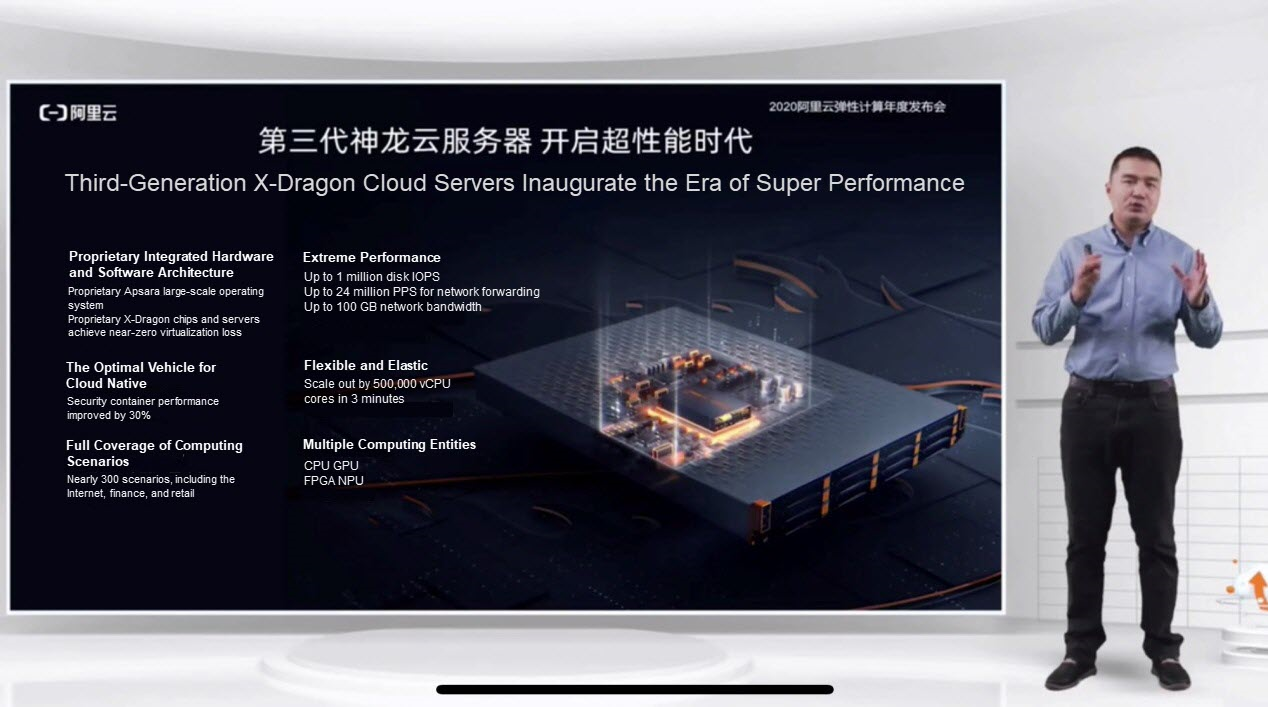
(Third-generation X-Dragon cloud servers inaugurate the era of super performance)
First, let's look at the performance of X-Dragon. The third-generation X-Dragon cloud server product family provides up to 208 CPU cores and 6 TB memory. Their cloud disk input/output operations per second (IOPS) can reach 1 million, with a network forwarding traffic of up to 24 million and network bandwidth of up to 100 GB. These indicators are all the best in the industry. X-Dragon supports multiple computing entities, including CPUs, GPUs, NPUs, and FPGA. For rapid scaling, 500,000 vCPU cores can be ready in 3 minutes. X-Dragon is also the optimal vehicle for cloud-native.
From the launch of the first-generation X-Dragon servers in 2017 to the third generation in 2020, Alibaba Cloud has launched three generations of proprietary X-Dragon servers in just three years. Compared with the previous generation, the third-generation X-Dragon cloud servers improve overall performance by 160%, working at least 30% faster than any competing cloud servers. In short, they provide the best overall computing power among cloud servers in the world. In addition to many performance enhancements, Alibaba Cloud improved the stability of individual ECS instances from 99.95% to 99.975% and the stability of cross-zone multi-instance layouts from 99.99% to 99.995%. These stability indicators are the highest in the world.
Can an enterprise achieve the same performance and stability by buying an X-Dragon server and installing it in its own data center? The answer is no. This is because X-Dragon servers are not standalone servers that can be installed in an enterprise data center. Instead, they function only when being integrated with Alibaba Cloud's infrastructure. X-Dragon servers require the collaboration of tens or hundreds of thousands of integrated hardware-software devices to achieve their full potential.
The functionality of X-Dragon servers can be seen from shipping containers that reformed the world over the last century. In the 1950s, the invention of shipping containers shortened ocean shipping times by 85%, reducing shipping costs 30-fold. The significance of this innovation to human productivity cannot be overstated. However, product manufacturers cannot just buy a container and take it to their warehouse to enjoy enhanced logistical efficiency and productivity. Containers cannot work independently of the global infrastructure of cargo ships, docks, loading and unloading systems, railways, trucks, and other facilities. Containers completely revolutionized bulk cargo transportation because companies no longer had to buy their own ships. This led to a completely new way of thinking. In turn, the modern global system of logistics based on containers has changed the physical forms of containers and container facilities throughout the industrial chain. From the earliest container in 1830 to the first modern container in 1956, containers have changed dramatically.
Similarly, the public cloud model has to go through the same process. Ten years ago, the original public cloud system was built around independent servers, storage devices, networks, and other equipment and software. Today, the global public cloud system will lead to a redesign of servers, storage devices, networks, and other equipment and software. The biggest change lies in the transformation from standalone devices to interconnected standardized facilities. In an interconnected standardized system, you cannot extract an individual component and expect it to provide the capabilities of the entire system.
For Alibaba Cloud ECS instances, the X-Dragon computing platform, Apsara Distributed File System storage platform, and Apsara Cloud Network System network platform, together with the Alibaba Cloud Linux 2.0 operating system and cloud-native software system allow for better capabilities between cloud platforms to enable higher performance.
Over the past decade, Alibaba Cloud started from scratch and gradually improved its products and services by serving major customers. We launched ECS 1.0 for webmasters of small- and mid-sized enterprises in 2010. In 2015, we released ECS 2.0 for some challenging scenarios, such as 12306.cn. Then, in 2017 and 2018, our X-Dragon architecture provided support for the Double 11 Global Shopping Festival. "You could say that over 10 years of development, we have reshaped the entire computing service model and developed the capabilities to serve all business scenarios", said Zhang Xiantao.
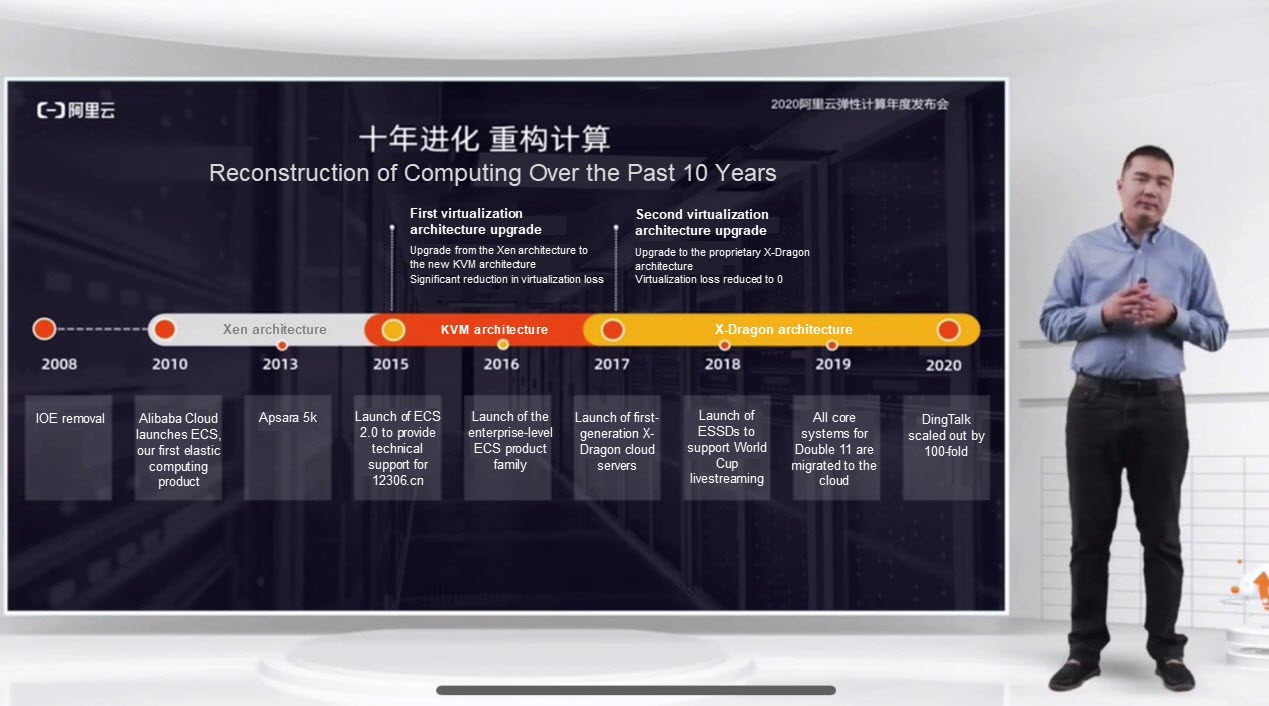
(Alibaba Cloud's evolution over a decade)
What will cloud computing look like over the next decade? Over the past 2-3 years, Alibaba Cloud has been asking this question and exploring the answers. In September 2019, Alibaba Cloud released its third-generation X-Dragon architecture, which comprehensively upgraded the service capabilities of X-Dragon servers. This proprietary integrated hardware-software architecture greatly improves computing efficiency and network and storage service capabilities. Based on third-generation X-Dragon cloud servers, Alibaba Cloud created its next-generation ECS product family, including 6th-generation enhanced instances, 7th-generation high clock-speed instances, memory-enhanced hardware instances, new-generation GPU instances, NPU instances, supercomputing cluster instances, and the world's first persistent memory instances.
The value of third-generation X-Dragon cloud servers is passed to users in the form of ECS instances. The 6th-generation enhanced ECS instances are composed of computing, storage, and network components. For computing, ECS instances use Alibaba Cloud's proprietary Dragonfly Hypervisor, instead of KVM, XEN, or another virtualization architecture. The lightweight Dragonfly Hypervisor consumes fewer resources and significantly increases virtualization efficiency while reducing computing jitters to several millionths. In terms of storage, 6th-generation enhanced instances come standard with enhanced SSD (ESSD) cloud disks. The latest generation of ESSDs can reach 1 million IOPS per disk, with a single-channel latency as low as 100 microseconds. The outstanding performance of ESSDs greatly improves the storage capabilities of the 6th-generation enhanced instances. For network capabilities, Alibaba Cloud's proprietary X-Dragon architecture provides excellent network I/O capabilities, with up to 24 million forwarding PPS per disk and a packet latency as low as 21 microseconds. These highlights ensure industry-leading network capabilities.
The 6th-generation enhanced instances combine the advantages of third-generation ECS Bare Metal (EBM) instances, Alibaba Cloud proprietary software and hardware, and other technologies. For example, a single ESSD provides 1 million IOPS, 4 Gbit/s throughput, 100-ms latency, and 5s-or-less snapshot backup intervals. By integrating these capabilities with third-generation X-Dragon cloud servers, the result is exceptionally powerful. In terms of networking, the 6th-generation enhanced instances provide forwarding capabilities of 24 million PPS, while the top performers in the industry are 10 million PPS. In addition, the 6th-generation enhanced instances feature a packet latency of 21 microseconds, compared to 30 microseconds from its nearest competitor. The 6th-generation enhanced instances support over 100 ENIs, while other instances in the industry only support up to 20.
In addition to their superiority in single-point applications, the 6th-generation instances also provide unparalleled end-to-end performance. In MySQL scenarios, these instances perform 190% better than any competitor. In Nginx scenarios, they outperform other competitors by up to 86%. In Redis scenarios, they outperform other competitors by up to 103%. Zhang Xiantao emphasized that, whether in terms of computing, networking, storage, or end-to-end performance, Alibaba Cloud 6th-generation enhanced ECS instances are superior to any competing products.
From the unparalleled performance of Alibaba Cloud 6th-generation enhanced ECS instances, we can better understand Alibaba Cloud's views on the evolution of cloud computing technology and especially public cloud technology over the next decade. The large-scale operations and overall coordination of public clouds will drive a reconstruction in the underlying software, hardware, and applications to support larger-scale public clouds. Simply put, a chemical reaction between software and hardware in public cloud systems will create new species of products and services.
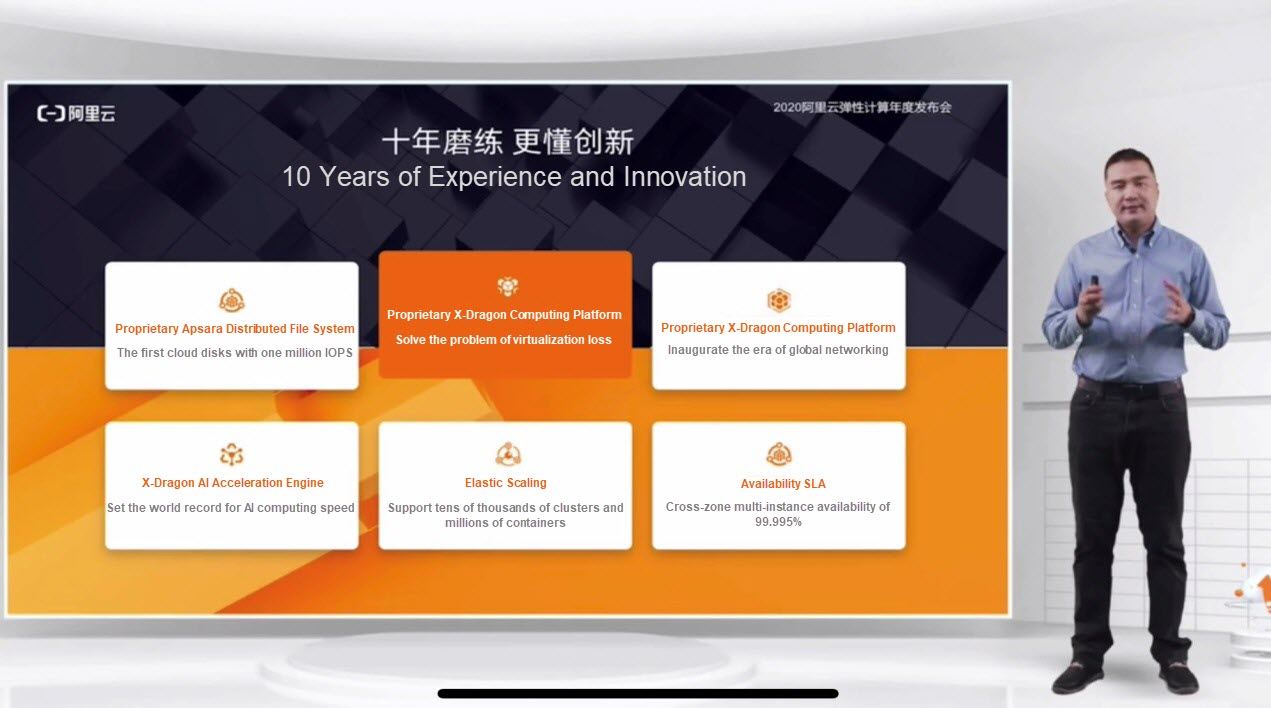
(Alibaba Cloud's experience over the past decade)
In terms of software, Alibaba Cloud has comprehensively implemented cloud-native. Without a doubt, cloud-native is the cloud computing standardization technology of the present and future. This has been especially true since 2019 when Kubernetes and container technology laid a foundation for cloud-native technology and attained absolute dominance in the market. Kubernetes and containers are the equivalents of a set of standards for shipping containers, cargo ships, and docks in the maritime logistics industry. They compose the system of technical standards that will define cloud computing for the next decade and beyond.
Alibaba Cloud is now going all-in on cloud-native. Since Alibaba's movement towards containers in 2011, Alibaba has been on a journey in the direction of cloud-native for 10 years. Over this decade, Alibaba Cloud has drawn on the strength of the richest selection of container products and services in the industry to grow in excess of 400% for several years in a row. Alibaba Cloud offers a rich portfolio of products and services in the container, service mesh, and serverless sectors. We have China's largest family of cloud-native products, have made the most comprehensive contributions to the open-source cloud-native community, have experience with the largest cloud-native applications, and possess the largest cloud-native customer base. We provide over 20 products and services in 8 categories, including underlying infrastructure, data intelligence, and distributed applications. Our products and services can meet the needs of a wide range of industry scenarios.
In Gartner's 2020 report on container services, Alibaba Cloud was the only Chinese vendor ranked. In March 2020, Gartner published its second Competitive Landscape: Public Cloud Container Services report. This report compares 10 features, including serverless Kubernetes, service mesh, and container images. Providing 9 of the 10 features, Alibaba Cloud and AWS offer a more comprehensive product portfolio than all of the other vendors.
The cloud-native software capabilities of Alibaba Cloud combine with our X-Dragon servers and other proprietary hardware to produce a chemical reaction. For example, the 6th-generation enhanced instances provide more than 100 ENIs, and the increase in the number of network interface controllers (NICs) per instance significantly improves container performance. However, the combination of EBM instances and container technology can provide higher performance than physical machines. Specifically, the difference in performance between EBM instances that run containers and X-Dragon and physical servers of the same specifications is 20% to 30%. Moreover, EBM instances also support Alibaba Cloud security containers, improving end-to-end security and isolation capabilities while increasing performance by 30% compared with open-source solutions. In addition, EBM instances support Alibaba Cloud's new confidential computing containers to effectively ensure data security through the integration of hardware and software.
Alibaba ran the 2019 Double 11 Global Shopping Festival on X-Dragon EMB instances, increasing its performance by 20% to 30% and reducing total costs by more than 50%. During the COVID-19 pandemic, the container + EBM solution has provided exceptional performance in helping DingTalk deal with the heaviest traffic it has ever experienced. Previously, DingTalk was completely deployed on common physical machines. However, it saw a sharp increase in use because government institutions, enterprises, and schools all needed to turn to online collaboration during the pandemic. In response, DingTalk adopted a cloud-based elastic deployment solution based on EBM instances and containers. This allowed DingTalk to quickly scale out its computing capabilities by 100,000 CPU cores, providing the necessary support for its business applications.
Zhang Jianfeng, the President of Alibaba Cloud Intelligence, recently said that the cloud is a new computing architecture that represents a comprehensive upgrade from the large and compact servers of the PC era. The cloud is characterized by distribution. It places a greater emphasis on elasticity based on Internet distribution as well as more powerful and extensive scheduling, reuse, and security. This is a very important feature of the cloud. The development of cloud computing requires a complete cloud system. Over the past decade, Alibaba Cloud has refined this kind of system. Over the next ten years, Alibaba Cloud will use this cloud system to reconstruct its underlying hardware and software to support a larger-scale public cloud.
Alibaba Sets New Record on Inference Performance, 5x Faster than Nearest Rival
Alibaba Cloud Savings Plans: Cost Optimization Provided by Cloud-Native

33 posts | 12 followers
FollowAlibaba Clouder - February 24, 2021
Alibaba Cloud Storage - February 10, 2021
Alibaba Clouder - February 24, 2021
Alibaba Cloud New Products - June 1, 2020
Alibaba Clouder - April 24, 2020
Alibaba Clouder - December 28, 2020

33 posts | 12 followers
Follow ECS(Elastic Compute Service)
ECS(Elastic Compute Service)
Elastic and secure virtual cloud servers to cater all your cloud hosting needs.
Learn More Function Compute
Function Compute
Alibaba Cloud Function Compute is a fully-managed event-driven compute service. It allows you to focus on writing and uploading code without the need to manage infrastructure such as servers.
Learn More Elastic High Performance Computing Solution
Elastic High Performance Computing Solution
High Performance Computing (HPC) and AI technology helps scientific research institutions to perform viral gene sequencing, conduct new drug research and development, and shorten the research and development cycle.
Learn More Elastic Container Instance
Elastic Container Instance
An agile and secure serverless container instance service.
Learn MoreMore Posts by Alibaba Cloud ECS